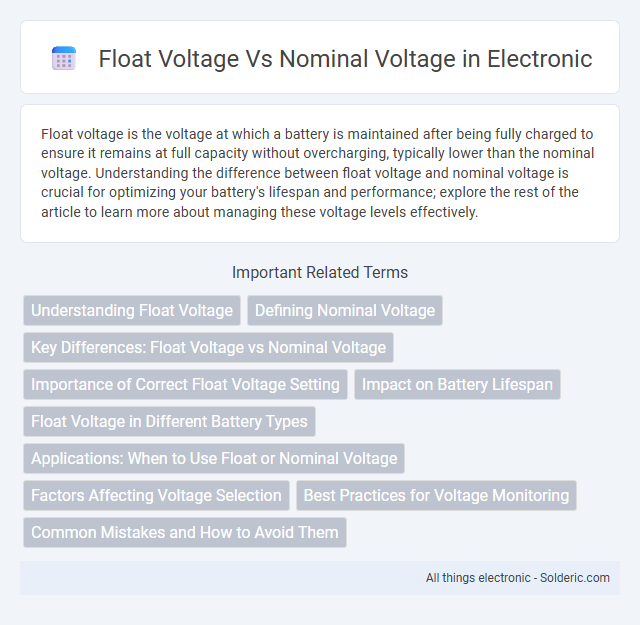Float voltage is the voltage at which a battery is maintained after being fully charged to ensure it remains at full capacity without overcharging, typically lower than the nominal voltage. Understanding the difference between float voltage and nominal voltage is crucial for optimizing your battery's lifespan and performance; explore the rest of the article to learn more about managing these voltage levels effectively.
Comparison Table
| Parameter | Float Voltage | Nominal Voltage |
|---|---|---|
| Definition | Voltage maintained to keep a battery fully charged without overcharging | Standard rated voltage of a battery or cell under normal operating conditions |
| Purpose | Maintain battery charge during standby or idle state | Indicate the voltage level when the battery is delivering power |
| Voltage Level | Typically slightly higher than nominal voltage (e.g., 2.25-2.30V per cell in lead-acid) | Standard value per cell or battery type (e.g., 2.0V per cell for lead-acid) |
| Application | Used in float charging modes, UPS systems, backup power supplies | Used for rating, sizing, and normal operation of batteries |
| Impact on Battery Life | Maintains full charge without damaging the battery if properly controlled | Represents normal operating voltage, no direct effect on lifespan |
Understanding Float Voltage
Float voltage refers to the voltage at which a battery is maintained after being fully charged to counteract self-discharge and prevent overcharging. Unlike nominal voltage, which represents the standard operating voltage (e.g., 12V for lead-acid batteries), float voltage is slightly higher and optimized to extend battery life during standby periods. Properly setting the float voltage is critical for battery health, ensuring maximum efficiency and longevity in applications such as uninterruptible power supplies and renewable energy systems.
Defining Nominal Voltage
Nominal voltage represents the standardized voltage level designated for electrical devices and systems, serving as a reference point for design and operation. Float voltage is a maintenance voltage slightly higher than the nominal voltage, used to keep batteries fully charged without overcharging. Understanding nominal voltage is crucial for correctly setting float voltage to ensure optimal battery life and performance.
Key Differences: Float Voltage vs Nominal Voltage
Float voltage is the specific voltage level at which a battery is maintained after full charge to prevent overcharging and prolong lifespan, typically slightly higher than the nominal voltage. Nominal voltage represents the standard or average voltage rating of a battery under typical operating conditions, serving as a baseline for design and compatibility purposes. Your battery's performance and longevity depend on correctly managing the float voltage relative to its nominal voltage for optimal efficiency.
Importance of Correct Float Voltage Setting
Correct float voltage setting is critical for maintaining battery health, as it prevents overcharging and extends battery lifespan in lead-acid or lithium-ion systems. Float voltage typically ranges slightly above the nominal voltage--about 2.25 to 2.30 volts per cell for lead-acid--ensuring batteries remain fully charged without excessive gassing or degradation. Precise adjustment reduces capacity loss and optimizes energy efficiency in renewable energy storage, uninterruptible power supplies (UPS), and backup power applications.
Impact on Battery Lifespan
Float voltage set slightly above nominal voltage maintains a battery's full charge without overcharging, significantly extending battery lifespan by preventing sulfation and electrolyte depletion. Excessive float voltage accelerates battery wear, reducing cycle life and capacity due to increased corrosion and gassing. Precise voltage regulation within manufacturer-recommended float voltage ranges ensures optimal battery health and maximizes overall longevity.
Float Voltage in Different Battery Types
Float voltage varies significantly across battery types, with lead-acid batteries typically set between 2.25 to 2.30 volts per cell to maintain full charge without overcharging. Lithium-ion batteries require a lower float voltage, usually around 3.6 to 3.7 volts per cell, to ensure safety and prolong battery life. Understanding the specific float voltage for your battery type is crucial for optimal performance and longevity.
Applications: When to Use Float or Nominal Voltage
Float voltage is used in battery-backed systems such as UPS and telecom to maintain full charge without overcharging, ensuring long-term battery health. Nominal voltage serves as the standard operating voltage for most electrical devices and systems during normal operation. Choosing float voltage is critical for standby power applications, while nominal voltage suits active, continuous-use circuits.
Factors Affecting Voltage Selection
Float voltage selection depends on factors such as battery chemistry, temperature, and application requirements. Lead-acid batteries typically require a float voltage of 2.25 to 2.30 volts per cell to prevent overcharging while maintaining full charge. Temperature compensation is crucial since float voltage decreases by approximately 3-5 millivolts per degree Celsius rise, ensuring battery longevity and optimal performance.
Best Practices for Voltage Monitoring
Float voltage typically maintains a battery's full charge without overcharging, while nominal voltage represents its average operating voltage. Best practices for voltage monitoring include regularly checking float voltage to prevent degradation and ensuring your system's monitoring equipment accurately distinguishes between float and nominal voltages. Implementing precise voltage thresholds helps maximize battery lifespan and maintain optimal performance.
Common Mistakes and How to Avoid Them
Common mistakes when comparing float voltage vs nominal voltage include confusing the constant maintenance voltage with the battery's rated capacity voltage, leading to improper charging and reduced battery lifespan. Float voltage is typically set slightly higher than the nominal voltage to maintain a fully charged battery without overcharging, so using nominal voltage for charging can cause underperformance or damage. To avoid these errors, always refer to manufacturer specifications for correct float voltage settings and monitor battery voltage regularly during the float charge phase.
Float voltage vs nominal voltage Infographic

 solderic.com
solderic.com